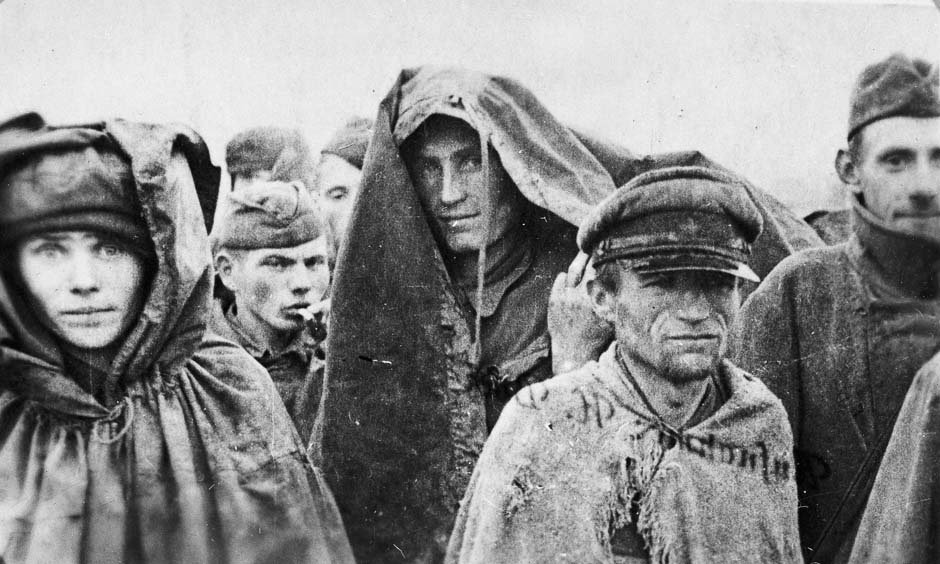Soviet POWs in WWII: Using Fiction to Highlight Survival, Not Death
Soviet POWs at Stalag XVIIIA near Wolfsberg in Austria, https://nzhistory.govt.nz/media/photo/russian-pows
According to various estimates, at least three million Soviet Prisoners of War (POWs) died while in Nazi custody during World War II.
The numbers are startling.
In October 1941, 5,000 Soviet POWs died every day.
By February 1942, 2 million of the 3.3 million Soviet soldiers in German custody up to that point had died from starvation, exposure, disease, or shooting.
Between June 1941 and January 1942, German Nazis killed an estimated 2.8 million Soviet POWs primarily through deliberate starvation, exposure, and summary execution.
During WWII, 57% of all Soviet POWs perished, contrasted by 3.6% of British and U.S. POWs
The numbers are startling, but the reasons, viewed through the eyes of Nazi ideology, are clear. According to Nazi race theory, the Slavs are considered sub-human or Untermenschen. Rather than viewing Soviet POWs as political enemies, they viewed them as racially less valuable and considered them obstacles that were taking up valuable German “living space” or Lebensraum. The genocide of Soviet POWs was exacerbated by the fact that the Soviet Union did not ratify the 1929 Geneva Convention on Prisoners of War. The Geneva Convention provided an international standard for the protection of POWs—protections that allowed American and British POWs to receive supplies from the American and Canadian Red Cross. Those supplies were denied Soviet POWs. Rather, the Soviet POWs were starved to death, many receiving only 700 calories a day.
It’s under these circumstances we find Aaron Kramer and Tommy Burns in My Mother’s Secret by Alina Adams. Aaron, a Soviet POW, and Tommy, an American POW, find themselves on opposites sides of Stalag 3-K, a fictionalized Nazi POW camp on the Germany-Poland border. On the American/British side of camp conditions are poor but livable. On the Soviet side of camp conditions are abhorrent and unlivable. Being placed on the Soviet side was nothing short of a death sentence.
But wherever there is tragedy, there are stories of compassion and survival. These are the stories author Alina Adams uncovers amidst so much horror. “We get one fifth the food ration the American soldiers get,” a sickly Soviet POW tells Regina, our main character in My Mother’s Secret who is acting as a nurse in camp. “No Red Cross packages for us,” he says, asking her not to report the death of a fellow soldier so that those still alive can collect his rations. Regina agrees despite the risks. Then, later, she discovers that Tommy Burns, the American soldier who befriended her, is secretly sneaking supplies from his side of camp to the Soviet side. As seen through Regina’s eyes, Alina Adams writes:
The Americans huddled on their side. Aaron stood on his. The Nazi guard approached, looking almost casual. Another moment and he might start whistling. Tommy raised his arm and a tiny, paper object went sailing over the wire into the dirt of no-man’s land. Regina strained to make out what it was.
Lucky Strike, read the package. Cigarettes. The five-pack was distributed to American soldiers by the Red Cross on humanitarian grounds; they were vital for health.
The guard swooped down to pick up his booty, then walked away, never having looked at the prisoners on either side. But the exchange wasn’t over. Once their guard pointedly turned his back, Tommy and the others pulled their arms behind their heads like hefting those US footballs which never made sense to Regina—what was the point of a ball that wasn’t round and couldn't bounce? They let fly a barrage of items to crash on Aaron’s side of the wire. Regina recognized cans of powdered milk, packages of prunes, bars of soap, blocks of cheese and K-ration biscuits. Many of the throws overshot and sailed behind Aaron. Regina expected the men were putting all their strength into the effort since anything that failed to reach their destination and landed short wouldn’t exactly be picked up, dusted off, and handed over. It would be lost forever, ending up in the guard’s pocket. And the Soviets couldn’t afford to sacrifice a single calorie.
Tommy wasn’t betraying Aaron and the rest. He was trying to save their lives.
Regina cries when she sees and understands the risks Tommy and the American soldiers were taking to help Aaron and the Soviet soldiers—real risks with real life or death consequences. Sadly, these were the choices that many on both sides of the war—on all sides of the war—were left with. Millions upon millions died unnecessarily. But how many were saved? How many risks were taken on behalf of another. In My Mother’s Secret those risks, those sacrifices, and those choices are made all too real.
Do you enjoy reading books that bring history to life? Check out all of our novels on our Titles Page.
Sources:
Wikipedia contributors, "German atrocities committed against Soviet prisoners of war," Wikipedia, The Free Encyclopedia, https://en.wikipedia.org/wiki/German_atrocities_committed_against_Soviet_prisoners_of_war (accessed November 6, 2022).
United States Holocaust Memorial Museum, “The Treatment of Soviet POWs: Starvation, Disease, and Shootings, June 1941–January 1942,” Holocaust Encyclopedia, https://encyclopedia.ushmm.org/content/en/article/the-treatment-of-soviet-pows-starvation-disease-and-shootings-june-1941january-1942, (accessed November 6, 2022).
“What Life Was Like For POWs In Europe During The Second World War,” Imperial War Museums, https://www.iwm.org.uk/history/what-life-was-like-for-pows-in-europe-during-the-second-world-war, (accessed November 6, 2022).



